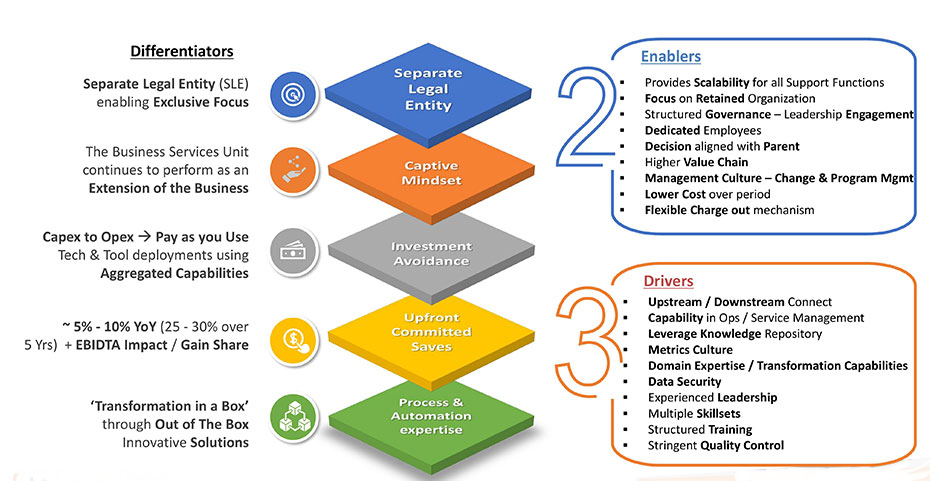Dedicated Captive...
...Enables focus on Your Core Business &
Transforms Your Support Functions
Core & Non-Core: Focusing on your company's core business is all about directing organizational and leadership energies and investments on the core products, services, customers, distribution channels and geographic areas that yield the largest return on your investment (ROI). Whether yours is a manufacturing or a services company, the functions that support the core business are called as Line Functions. The functions, beyond the core business, such as Finance, Procurement, Human Resources etc, are, therefore, referred to as Non-core or Support Functions but are equally mission critical since they too accomplish the overall goals and objectives of the organization. However, various business studies have proven that, despite the best possible intent, 65 to 70% of the organization’s time across levels and particularly for the mid to senior leadership, gets diverted from strategic business oriented activities to more transactional, support function related work, thereby affecting the pace of growth of the organization.
The Bridge: Almost 20+ years ago, successful global organizations like Proctor & Gamble, American Express & General Electric as well as Indian organizations like Hindustan Unilever, HDFC Bank, Dr Reddy’s & Ranbaxy have adopted the global strategy of Shared Services to unbundle and segregate processes of Support Functions and have consolidated them onshore and/or offshore to be operated as separate units, with all the demands and requirements of a typical 'Line Function' of the core business.
This strategic direction of Shared Services has become the bridge between leaders to enhance and deepen the focus on their Core Business Functions and in parallel, the leaders of the Shared Services transformed the Support Functions to become strategic enablers to the core business!
70:70:70 Rule: In fact, as early as the year 2000, Jack Welch, one of the most revered CEOs of GE, created a clear 70:70:70 Rule for the global conglomerate. This rule meant that 70% of the Support Functions could be consolidated, 70% out of this should be offshored, and out of this offshoring 70% must be in India. No doubt, India has 50% of the global offshore business!
Challenges: However, the strategic and financial benefits of Captive Shared Services or even outsourcing have largely been availed by large conglomerates (i.e. with Revenues over US$ 5 Bn, having multi location factories, offices and footprints), since the headcount for consolidation and offshoring was in thousands. For several manufacturing organizations and corporations with Revenues of US$ 500 Mn or even less than US$ 5Bn Revenues, this benefit was elusive in view of lower headcounts for consolidation, sometimes even below 500 headcounts. It is expensive to set up and maintain captive centres less than 500 headcounts, whether these are onshore or offshore. Also, these organizations and captive centres are challenged with capabilities and investments required to transform the processes in their captive centres and thereby drive transformation at the front end of the business. At the same time, when these organizations decide to outsource, they do not get the right kind of mindshare or attention from the Tier 1 or 2 Outsourcing Service Providers as they form a miniscule part of the business of the Service Provider.
These organizations that have low scale consolidation say starting as low as 50 or 100 headcounts to up to 500 headcounts and require investments in process capabilities and technology for transformational outcomes, the classical business services models of Inhouse Centres or Outsourcing do not meet their requirements at all. In the absence of a specific business services solution, these organizations missed out on the strategic opportunities to find the right balance to focus on both the Core Business Functions and the transformation of the Support Functions. This challenge is even more pronounced for an onshore centre, be it India to India or UK to UK or US to US.
Accordingly, the Founders have leveraged more than two decades of experience and expertise in Business Services and multiple structuring models-classical models or other models like BOT, BOM etc., - and promoted 'Quintes Global' as the venture to offer the Unique Business Services Solution for this specific Low Scale Segment and that innovative solution is 'Dedicated Captive'
Dedicated Captive (D-CapTM) is a New Age Solution for Business Services
that innovatively combines
Low Scale & High Capabilities and Operations & Transformation
Global First: D-CapTM is the ‘global first’ transformation centric model (in a way, a Disruptor Model!) meant for Organizations and Captive Centre Operations that are ‘low scale’ i.e. 50 to 500 headcounts and deploys process and technology Capabilities to drive transformation of Support Functions. This way the D-CapTM solution combines Low Scale and High Capabilities! On the other hand, our years of experience clearly confirms that managing and leveraging Operations is the best way (and in many ways a pre-requisite) to drive transformation of processes connecting Captive operations and the front end Business to co-create value, thereby, the D-CapTM solution innovatively combines Operations and Transformation for the Low Scale units. Overall, D-CapTM solution uniquely provides ‘the best and removes the challenges’ of the two major Classical Operating Models for Business Services i.e. Pure play Captive and Outsourcing models.
Agility & Sustainability: Transformation Centricity is the foundation for the D-CapTM Solution. Transformation mindset involves a conscious and committed journey from the current state (point of departure – POD) to a future state (point of arrival – POA). This mindset is woven into the TWO components of the D-CapTM Solution and the Transformation Journey is continuous to enable agility and sustainability, the two pillars for businesses in the post Covid World.
Two Inter-connected Components: D-CapTM comes with TWO interlinked, intertwined components, with BOTH components being ‘ARROW Heads' for driving transformation and co-creating value and business impact:
TCaaS
Transformation Capability as a Service
Aggregated Capabilities for transformation of all DTUs
from Roadmap to execution and end to end process &
technology transformation of Parent Companies
Dedicated Captive (D-CapTM) has TWO Interconnected Components with Composite Governance.

Differentiators of D-Cap

